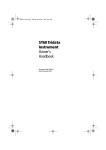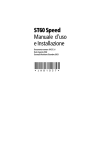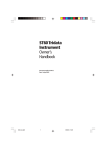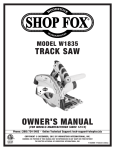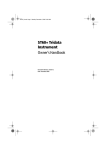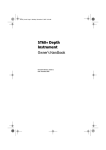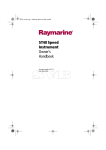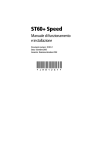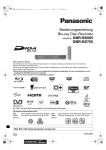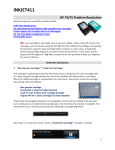Download Raymarine ST60 Specifications
Transcript
ST60 Speed Instrument Owner’s Handbook Document number: 81037-5 Date: 1 April 2004 Raymarine, ST60 and SeaTalk are trademarks of Raymarine Limited © Handbook contents copyright Raymarine Limited 2004 Preface i Preface Important information Safety notices WARNING: Product installation & operation This equipment must be installed and operated in accordance with the Raymarine instructions provided. Failure to do so could result in personal injury, damage to your boat and/or poor product performance. WARNING: Electrical safety Make sure you have switched off the power supply before you start installing this product. WARNING: Although we have designed this product to be accurate and reliable, many factors can affect its performance. Therefore, it should serve only as an aid to navigation and should never replace commonsense and navigational judgement. Always maintain a permanent watch so you can respond to situations as they develop. EMC conformance All Raymarine equipment and accessories are designed to the best industry standards for use in the recreational marine environment. The design and manufacture of Raymarine equipment and accessories conform to the appropriate Electromagnetic Compatibility (EMC) standards, but correct installation is required to ensure that performance is not compromised. Handbook information To the best of our knowledge, the information in this handbook was correct when it went to press. However, Raymarine cannot accept liability for any inaccuracies or omissions it may contain. In addition, our policy of continuous product improvement may change specifications without notice. Therefore, Raymarine cannot accept liability for any differences between the product and the handbook. ii ST60 Speed Instrument Owner’s Handbook Preface iii Contents Preface ......................................................................................................................i Important information ..................................................................................... i Safety notices .......................................................................................... i EMC conformance ................................................................................... i Handbook information ............................................................................ i Contents ........................................................................................................ iii Introduction ...................................................................................................vii Data inputs ....................................................................................................vii SeaTalk ..................................................................................................vii Stand alone operation ..........................................................................viii Remote control .............................................................................................viii Mounting options .........................................................................................viii Parts supplied ................................................................................................ ix Chapter 1: Operation ............................................................................................1 1.1 Getting started ....................................................................................... 1 Displayed information ............................................................................ 1 1.2 Normal operation ................................................................................... 1 Speed information ................................................................................. 1 Current speed .................................................................................. 1 Maximum speed .............................................................................. 1 Average speed ................................................................................. 2 Velocity made good (to windward) .................................................. 2 Speed over ground ........................................................................... 3 Log, trip and water temperature ............................................................ 3 Log ................................................................................................... 3 Trip ................................................................................................... 3 Water temperature .......................................................................... 4 Timers .................................................................................................... 4 Race-start timers .............................................................................. 5 1.3 Display settings ...................................................................................... 5 Illumination ............................................................................................ 5 Contrast ................................................................................................. 6 1.4 Pop-up Pilot ............................................................................................ 6 1.5 Remote control ...................................................................................... 6 Chapter 2: Maintenance & Troubleshooting .....................................................7 2.1 Maintenance .......................................................................................... 7 Servicing and safety ............................................................................... 7 Instrument ............................................................................................. 7 Transducer ............................................................................................. 7 Cabling ................................................................................................... 8 iv ST60 Speed Instrument Owner’s Handbook 2.2 Troubleshooting .....................................................................................8 Preliminary procedures ...........................................................................8 Fixing faults ............................................................................................8 Technical support ....................................................................................9 World wide web ...............................................................................9 Telephone help line ..........................................................................9 Help us to help you ...........................................................................9 Chapter 3: Installation .......................................................................................11 3.1 Planning your installation .....................................................................11 Site requirements .................................................................................11 Transducer ......................................................................................11 Instrument ......................................................................................13 EMC installation guidelines ..................................................................14 Suppression ferrites ........................................................................15 Connections to other equipment ....................................................15 3.2 Procedures ...........................................................................................15 Unpacking ............................................................................................15 Fitting the instrument ...........................................................................16 Surface mounting ...........................................................................16 Flush mounting ..............................................................................17 Fitting the low-profile bezel ......................................................17 Flush mounting procedure .......................................................18 Bracket mounting ...........................................................................19 Fitting transducer .................................................................................20 Running transducer cable ...............................................................20 Connecting the instrument ...................................................................21 Types of connection ........................................................................21 Signal connections .........................................................................21 Power supply connections ..............................................................22 SeaTalk systems .......................................................................22 Stand alone instruments ..........................................................23 Chapter 4: Calibration ........................................................................................25 4.1 Introduction ..........................................................................................25 EMC conformance ................................................................................25 Speed readings .....................................................................................25 4.2 User calibration ....................................................................................26 Procedure .............................................................................................26 Set speed units ...............................................................................26 Set resolution .................................................................................26 Set log units ....................................................................................26 Preface v Setting the correct speed ............................................................... 29 Adjust to SOG .......................................................................... 29 Cal factor adjust ....................................................................... 29 Set temperature units .................................................................... 29 Temperature calibration ................................................................. 29 Timer buzzer .................................................................................. 29 Pop-up pilot ................................................................................... 30 Leaving User calibration ................................................................ 30 4.3 Intermediate calibration ....................................................................... 30 Speed calibration ................................................................................. 31 Leaving Intermediate calibration ......................................................... 34 4.4 Dealer calibration ................................................................................. 34 User calibration on/off ......................................................................... 34 Response settings ................................................................................ 36 Boat show mode .................................................................................. 36 Factory defaults .................................................................................... 36 Leaving Dealer calibration ................................................................ 36 vi ST60 Speed Instrument Owner’s Handbook Preface vii Introduction Thank you for purchasing a Raymarine product. We are sure your ST60 instrument will give you many years of trouble-free operation. This handbook describes how to install and use the Raymarine ST60 Speed instrument. This instrument provides accurate speed, log, trip and timer information, on a high quality Liquid Crystal Display (LCD). The instrument is constructed in a rugged weather-proofed case to provide reliable performance, even under the most demanding conditions. 2-3 32 D4 Data inputs The ST60 Speed instrument receives data either from an appropriate speed transducer and/or from a SeaTalk instrumentation system. SeaTalk SeaTalk enables a number of compatible instruments to operate as a single, integrated navigational system. Instruments in a SeaTalk system are linked by means of a single cable, which feeds both power and data. Instruments can therefore be added to the system by plugging them into the network. SeaTalk is flexible enough to adapt to any number of compatible instruments without requiring a central processor. SeaTalk can also communicate via an interface, with non-SeaTalk equipment using the internationally-accepted National Marine Electronics Association (NMEA) protocol. In a SeaTalk system, each instrument can be either a master or dedicated repeater unit. A master instrument is directly connected to a transducer (the device that provides the raw data), and provides data and control for the service it is viii ST60 Speed Instrument Owner’s Handbook providing, to all other equipment on the SeaTalk network. A slave instrument is not directly connected to a transducer but repeats information provided by other equipment in the SeaTalk network. The ST60 Speed instrument can fulfil both master and repeater roles. Stand alone operation In Stand alone operation, the ST60 Speed instrument is connected only to the relevant transducer and does not display information from, or provide information to, any other instruments. Remote control When connected to SeaTalk, the ST60 Speed instrument can be controlled remotely by a SeaTalk Remote Keypad Unit, to provide instant remote access to the various display readouts. Mounting options If you do not want to surface mount your ST60 instrument, options are available for: • Flush mounting. If you have ordered the flush mounting option a low-profile bezel and four fixing screws are provided. • Bracket mounting. Preface ix Parts supplied Unpack your ST60 instrument and check that the following items are present: • Item 1, ST60 Speed instrument fitted with standard bezel for surface mounting. • Item 2, Fixing studs (2). • Item 3, Thumb nuts (2). • Item 4, Gasket. • Item 5, Speed transducer, plus bung (not illustrated). • Item 6, SeaTalk interconnection cable. • Item 7, Power cable. • Item 8, Instrument Cover. • Item 9, Owner’s Handbook. A Warranty document and fitting templates are included in this Handbook. • Item 10, Cue Card. Spare spade terminals are also provided, to re-terminate the transducer cable if it has to be cut to facilitate installation. Note: The above packing list is for an ST60 Speed system. Where an instrument is purchased separately, a transducer is not included. x ST60 Speed Instrument Owner’s Handbook 4 1 5 8 2 3 6 2 3 7 ST60 Speed Instrument Owner's Handbook 9 10 D4439-3 Chapter 1: Operation 1 Chapter 1: Operation 1.1 Getting started Displayed information Your ST60 Speed instrument provides the following: • Speed information. • Log, trip and water temperature information. • Count-up and race-start timers. CAUTION: Calibration requirement The ST60 Speed instrument is calibrated to default settings when supplied. To ensure optimum performance on your boat, this product MUST be calibrated before use. Do NOT use the product until it has been calibrated using the procedures in Chapter 4, Calibration. 1.2 Normal operation Use the flow charts in this Chapter to operate your ST60 Speed instrument. The flow charts show the sequence of key presses and displays for the various operating tasks. All key presses are momentary unless otherwise stated. Speed information The speed key gives access to current speed, maximum speed, average speed, velocity made good (VMG) and speed over ground (SOG) information. Refer to the Using speed key flow diagram to access the information you want. Current speed Speed measurement units can be either knots (KTS), miles per hour (MPH) or kilometers per hour (KMH). The required units are selected during user calibration (see Chapter 4, Calibration ). Maximum speed The maximum speed is reset at power up. It can also be reset manually by pressing the reset key for 3 seconds. The display shows the maximum recorded speed since the last reset. This screen times-out to current speed if no user action occurs for 7 seconds. 2 ST60 Speed Instrument Owner’s Handbook Average speed The average speed is reset at power up. It can also be reset manually by pressing the reset key for 3 seconds. The display shows the average speed calculated since the last reset. This screen times-out to current speed if no user action occurs for 7 seconds. speed Current speed speed speed Maximum speed Speed over ground 7 second timeout Press for 3s reset to reset speed speed Velocity made good Average speed 7 second timeout speed Using the speed key D4363-2 Velocity made good (to windward) Velocity made good (VMG) information is available if your ST60 Speed instrument is part of a SeaTalk system to which a SeaTalk-compatible wind instrument is also connected. Chapter 1: Operation 3 Speed over ground Speed over ground (SOG)information is available if your ST60 Speed instrument is part of a SeaTalk system to which a suitable GPS is also connected. Log, trip and water temperature The trip key gives access to log, trip and water temperature information. Refer to the Using trip key flow diagram to access the information you want. trip Log trip trip Trip distance Press Water temperature reset for 3 s to return TRIP value to 0 trip Using trip key D4364-2 Log The Log screen shows the total distance covered by the vessel since the ST60 Speed instrument was fitted. Trip The trip distance is reset at power up and may also be reset manually, by pressing the reset key for 3 seconds. The display shows the distance covered since the last reset. Note: The trip distance can be reset only if the instrument is a master, i.e. connected to a speed transducer. 4 ST60 Speed Instrument Owner’s Handbook Water temperature The water temperature is shown in either degrees Celsius or Fahrenheit, as set during calibration (see Chapter 4, Calibration ). Timers The timer key gives access to a count-up timer and to two race-start timers. Times are either in seconds (S) or minutes (M), depending on the counter values. Refer to the Using timer key flow diagram to display the required timer. timer Count-up timer timer timer Race-start timer 1 Race-start timer 2 Press reset either momentarily to start timer, or for lap time (when running) or for 1 s to reset timer to the start value. timer To enter/leave adjust mode, press To enter/leave adjust mode, press Race-start timer adjust timer and reset timer and reset momentarily momentarily To set a different value, press Using timer key timer reset to decrease the value to increase the value D4365-3 Chapter 1: Operation 5 Once you have selected the required timer display, press the reset key to start the timer running. When a timer is running, the delimiter (i.e. ‘.’or ‘:’) flashes. For lap timing, press the reset key. To stop and reset a timer to the start value, hold down the reset key for 1 second. Once a timer is running, you can leave the timer page and select any other display. The counter will continue to run in the background. Race-start timers You can set each race-start timer to any whole-minute value from 1 to 15 minutes. Note: When the instrument is first installed, the race-start timers are set to 4 and 5 minutes respectively. To set a race-start timer: 1. Use the timer key as shown in the Using timer key flow diagram to select the required race-start timer. 2. Simultaneously press the timer and reset keys to enter the race-start timer adjust mode. 3. Use either the timer or reset key to set the required value. 4. Simultaneously press the timer and reset keys to save the value and leave the race-start timer adjust mode. If you are using one of the race-start timers and the timer buzzer is enabled, the buzzer will: • Double-beep every minute. • Beep three times at the start of the last 30 seconds. • Beep once for each of the last 10 seconds. • Beep for 2 seconds at zero. The timer buzzer is enabled or disabled as part of the calibration procedure (see Chapter 4, Calibration ). Note: After a race-start timer has counted-down to zero, it will then start counting up. 1.3 Display settings Illumination When the instrument is first powered up, the display illumination is set to its lowest (courtesy) level to facilitate initial access to the keys. To adjust the level of illumination: 1. Hold down the speed key for approximately one second, to enter the illumination-adjust mode. 6 ST60 Speed Instrument Owner’s Handbook 2. There are four preset illumination levels. Press the speed key to cycle through these levels until you reach the level you want. 3. Press any other key to leave the illumination-adjust mode. Note: The display will time out to normal operation 7 seconds after the last key press. Contrast To adjust the display contrast: 1. Hold down the speed key for approximately two seconds, to enter the contrast-adjust mode. 2. There are four preset contrast settings. Press the speed key to cycle through these settings until you achieve optimum display quality. 3. Press any other key to leave the contrast-adjust mode. Note: The display will time out to normal operation 7 seconds after the last key press. 1.4 Pop-up Pilot A Pop-up Pilot facility enables instruments connected to SeaTalk to constantly monitor any changes to the autopilot mode and to the course settings. If one of these parameters changes, the new value is immediately displayed on the ST60 instrument for 5 seconds, after which time the display reverts to the previous display. This facility can be enabled or disabled during User calibration (see Chapter 4, Calibration ). 1.5 Remote control When connected to SeaTalk, the ST60 Speed instrument can be controlled remotely with a SeaTalk Remote Keypad Unit. Remote control of an instrument is indicated by a REMOTE legend on the display, to indicate that the keypad has control. Details on how to use the remote control facility can be found in the SeaTalk Remote Keypad Owner’s Handbook. Chapter 2: Maintenance & Troubleshooting 7 Chapter 2: Maintenance & Troubleshooting 2.1 Maintenance Servicing and safety • Raymarine equipment should be serviced only by authorised Raymarine service technicians. They will ensure that servicing procedures and replacement parts used will not affect performance. There are no user-serviceable parts in any Raymarine product. • Some products generate high voltages, and so never handle the cables/connectors when power is being applied to the equipment. • When powered up, all electrical equipment produces electromagnetic fields. These can cause adjacent pieces of electrical equipment to interact with one another, with a consequent adverse effect on operation. In order to minimise these effects and enable you to get the best possible performance from your Raymarine equipment, guidelines are given in the installation instructions, to enable you to ensure minimum interaction between different items of equipment, i.e. ensure optimum Electromagnetic Compatibility (EMC). • Always report any EMC-related problem to your nearest Raymarine dealer. We use such information to improve our quality standards. • In some installations, it may not be possible to prevent the equipment from being affected by external influences. In general this will not damage the equipment but it can lead to spurious resetting action, or momentarily may result in faulty operation. Instrument Certain atmospheric conditions may cause condensation to form on the instrument window. This will not harm the instrument and can be cleared by increasing the illumination setting to Level 3. Periodically clean your ST60 instrument with a soft damp cloth. Do NOT use chemical and abrasive materials to clean the instrument. Transducer Refer to the Installation and Maintenance instructions supplied with the transducer. 8 ST60 Speed Instrument Owner’s Handbook Cabling Examine all cables for chafing or other damage to the outer shield and, where necessary, replace and re-secure. 2.2 Troubleshooting Preliminary procedures Changes in the electronic environment may adversely affect the operation of your ST60 equipment. Typical examples of such changes are: • Electrical equipment has recently been installed or moved aboard your vessel. • You are in the vicinity of another vessel or shore station emitting radio signals. If you appear to have a problem, first ensure that the EMC requirements are still being met before further investigating the problem. Fixing faults All Raymarine products are subjected to comprehensive test and quality assurance programmes prior to packing and shipping. However, if a fault occurs, the following table may help to identify and rectify the problem. Fault Cause Remedy Display blank No power supply Check power supply. Check SeaTalk cabling and connector security Check fuse/circuit breaker No transfer of information between SeaTalk instruments (e.g. illumination levels). SeaTalk cable or connector fault Failure of a group of SeaTalk instruments. SeaTalk cable or connector fault No speed or temperature information Transducer cable or Check the condition of the transconnector fault ducer cable and the security of the connections No speed information. Temperature available. Transducer paddle wheel fouled Check security of SeaTalk connectors. Check condition of SeaTalk cables. Isolate faulty instrument by disconnecting instruments one by one. Check the security of SeaTalk connectors between functioning and non-functioning instruments Clean paddle wheel. See CAUTION below Chapter 2: Maintenance & Troubleshooting 9 CAUTION: If you need to remove the transducer insert, have the transducer bung to hand and secure it in the transducer body immediately after the insert has been removed, to prevent excessive ingress of water. Technical support Raymarine provides a comprehensive customer support service, on the world wide web and by telephone help line. Please use either of these facilities if you are unable to rectify a problem. World wide web Please visit the Customer Support area of our web site at: • www.raymarine.com As well as providing a comprehensive Frequently Asked Questions section and servicing information, the web site gives e-mail access to the Raymarine Technical Support Department and a details of the locations of Raymarine agents, worldwide. Telephone help line If you do not have access to the world wide web, please call our help line. In the USA, call: • +1 800 539 5539, extension 2444 or • +1 603 881 5200 extension 2444 In the UK, Europe the Middle East or the Far East, call: • +44 (0) 23 9271 4713 (voice) • +44 (0) 23 9266 1228 (fax) Help us to help you When requesting service, please quote the following product information: • Equipment type. • Model number. • Serial number. • Software issue number. The Software issue number can be ascertained by means of the Intermediate Calibration facility, see Chapter 4, Calibration. 10 ST60 Speed Instrument Owner’s Handbook Chapter 3: Installation 11 Chapter 3: Installation This chapter describes how to install the ST60 Speed instrument, and associated speed transducer. The transducer is fitted in the hull of the vessel and is connected to the rear of the instrument. The actual type of transducer depends on the type of hull in which it is to be installed. For advice, or further information regarding the installation of this equipment, please contact the Raymarine Product Support Department or your own National Distributor. 3.1 Planning your installation Before starting the installation, spend some time considering the best positions for both transducer and instrument, such that the Site requirements and the EMC installation guidelines (below) are satisfied. Site requirements Transducer 3.95 in (100 mm) 2.94 in (75 mm ) diameter 2.00 in (51 mm) diameter 0.57 in (14 mm) 2.94 in (75 mm) diameter Plastic through hull speed transducer dimensions D4446-3 12 ST60 Speed Instrument Owner’s Handbook The transducer types required for the various hull types are as follows: Hull material Transducer type Glass reinforced plastic (GRP) M78712 Through hull plastic Steel M78712 Through hull plastic Aluminium M78712 Through hull plastic Wood M78716 Through hull bronze Other transducer types are also available for specific requirements. For further details, contact your local Raymarine dealer. For accurate speed readings the transducer should be sited within the clear water flow areas indicated by the shaded areas in the following diagram. Sailing vessel Planing power vessel Displacement power vessel Transducer siting D4349-1 The transducer should also: • Be ahead of the propellers (by a minimum of 10% of the water line length). • Be at least 6 in (150 mm) away from the keel (ideally ahead of the keel if a sailing yacht). • Be as near as possible to the center line of the vessel. • Be clear of other through-hull fittings or projections. Chapter 3: Installation 13 • Have sufficient clearance inside the hull to fit the nut. • Have 4 in (100 mm) of headroom to allow for withdrawal. There must also be a viable route for the transducer cable to be routed to the instrument. 0.95 in (24 mm) 0.6 in (15 mm) 3.54 in (90 mm) diameter 4.33 in (110 mm) With low profile bezel 4.85 in (123 mm) ST60 instrument dimensions 4.85 in (123 mm) With standard bezel 4.53 in (115 mm) 3.54 in (90 mm) diameter Instrument 0.25 in 1.4 in (6.2 mm) (35 mm) D5785-4 CAUTION: The presence of moisture at the rear of the instrument could cause damage either by entering the instrument through the breathing hole or by coming into contact with the electrical connectors. ST60 instruments can be fitted either above or below deck, provided the rear of the instrument is sited where it is protected from contact with water. Each instrument must also be positioned where: • It is easily read by the helmsman. • It is protected against physical damage. • It is at least 9 in (230 mm) from a compass. 14 ST60 Speed Instrument Owner’s Handbook • It is at least 20 in (500 mm) from radio receiving equipment. • There is reasonable rear access for installation and servicing. EMC installation guidelines All Raymarine equipment and accessories are designed to the best industry standards for use in the recreational marine environment. Their design and manufacture conforms to the appropriate Electromagnetic Compatibility (EMC) standards, but correct installation is required to ensure that performance is not compromised. Although every effort has been taken to ensure that they will perform under all conditions, it is important to understand what factors could affect the operation of the product. The guidelines given here describe the conditions for optimum EMC performance, but it is recognized that it may not be possible to meet all of these conditions in all situations. To ensure the best possible conditions for EMC performance within the constraints imposed by any location, always ensure the maximum separation possible between different items of electrical equipment. For optimum EMC performance, it is recommended that wherever possible: • Raymarine equipment and cables connected to it are: • At least 3 ft (1 m) from any equipment transmitting or cables carrying radio signals e.g. VHF radios, cables and antennas. In the case of SSB radios, the distance should be increased to 7 ft (2 m). • More than 7 ft (2 m) from the path of a radar beam. A radar beam can normally be assumed to spread 20 degrees above and below the radiating element. • The equipment is supplied from a separate battery from that used for engine start. Voltage drops below 10 V in the power supply to our products, and starter motor transients, can cause the equipment to reset. This will not damage the equipment, but may cause the loss of some information and may change the operating mode. • Raymarine specified cables are used. Cutting and rejoining these cables can compromise EMC performance and must be avoided unless doing so is detailed in the installation manual. • If a suppression ferrite is attached to a cable, this ferrite should not be removed. If the ferrite needs to be removed during installation it must be reassembled in the same position. Chapter 3: Installation 15 Suppression ferrites The following illustration shows typical cable suppression ferrites used with Raymarine equipment. Always use the ferrites supplied by Raymarine. D3548-6 Connections to other equipment If your Raymarine equipment is to be connected to other equipment using a cable not supplied by Raymarine, a suppression ferrite MUST always be attached to the cable near the Raymarine unit. 3.2 Procedures As it is not possible to describe procedures for all possible installation scenarios, the procedures given here describe the broad requirements for installing Speed transducers and the ST60 Speed instrument. Adapt these procedures as appropriate, to suit your individual requirement. CAUTION: Where it is necessary to cut holes (e.g. for cable routing and instrument mounting), ensure that these will not cause a hazard by weakening critical parts of the vessel’s structure. Unpacking Unpack your ST60 equipment and check that the items described in the Preface are present. Each ST60 instrument is supplied with a standard bezel for surface mounting. Optional mounting kits are available for flush mounting and bracket mounting the instrument. If you have ordered the flush mounting option a low-profile bezel and four fixing screws are also provided. 16 ST60 Speed Instrument Owner’s Handbook Fitting the instrument The ST60 Speed instrument can be installed using one of a number of different mounting options: • Surface mounting. Gives a profile of approximately 0.95 in (24 mm). • Flush mounting. Gives a profile of approximately 0.25 in (6 mm). • Bracket mounting. The ST60 instruments can also be mounted behind a panel with just the instrument dial and keys visible. Surface mounting To surface mount your ST60 instrument (see the Surface mounting illustration): 1. Ensure that: • The selected location is clean, smooth and flat. • There is sufficient space behind the selected location to accommodate the rear of the instrument and connectors. 4 Surface mounting 1 2 1 3 5 2 5 D4334-2 2. Apply the surface mount template (supplied at the rear of this handbook) to the selected location and mark the centers for the fixing studs (1) and the aperture (3) that will take the rear casing of the instrument. 3. Drill out the two 0.2 in (5 mm) fixing stud clearance holes (2). 4. Cut out the clearance hole (3) then remove the template. Chapter 3: Installation 17 5. Peel off the protective sheet from the self-adhesive gasket (4) then stick the gasket into position on the rear of the instrument. 6. Screw the two fixing studs into the threaded sockets on the rear of the instrument. 7. Mount the assembled instrument, studs, bezel and gasket into the panel. Secure from behind with the thumb nuts (5). Flush mounting The Flush Mounting Kit uses a low-profile bezel to reduce the fitted profile of the instrument, to approximately 0.25 in (6 mm) above the panel fascia. Fitting the low-profile bezel In order to flush-mount your ST60 instrument, you must first replace the standard bezel with the low-profile bezel as follows: 1. Hold the instrument in both hands with the display towards you. D4537-2 2. Using both thumbs, gently press an upper corner of the instrument from the bezel, then remove the bezel from the instrument. Retain the rubber keypad which is released when the bezel is removed. 3. Referring to the Fitting the low-profile bezel illustration, place the instrument face upwards on a flat surface and place the rubber keypad (7) in position around the display window (i.e. so that each key outline is located over its associated key on the instrument). 4. Snap the low-profile bezel (8) in position over the instrument, so that the rubber keys are correctly located in the holes on the bezel. 18 ST60 Speed Instrument Owner’s Handbook 8 Fitting the low-profile bezel 7 9 D4360-2 CAUTION: It is essential that only screws of the correct size are used to secure the instrument to the bezel. Failure to observe this caution could result in damage to both the instrument and the bezel. 5. Using the four, self-tapping screws (9) provided, secure the instrument and bezel together. Fit the screws from the rear of the instrument and tighten them sufficiently to secure the instrument and bezel together. DO NOT OVERTIGHTEN. Flush mounting procedure Flush mount your instrument (see the Flush mounting illustration) as follows: 1. Assemble the ST60 instrument and low-profile bezel as described under Fitting the low-profile bezel. 2. Ensure that: • The panel on which you intend to mount the instrument is between 0.12 in (3 mm) and 0.78 in (20 mm) thickness. • The selected location is clean, smooth and flat. • There is sufficient space behind the selected location to accommodate the rear of the instrument and connectors. Chapter 3: Installation 19 3. Apply the flush mount template (supplied at the rear of this handbook) to the selected location and mark out the aperture into which the assembled instrument and bezel will sit. 4. Cut out the aperture (3) for the assembled instrument and bezel and remove the template. 5. Peel off the protective sheet from the self-adhesive gasket (4) then stick the gasket into position on the rear of the bezel. Flush mounting D4335-3 6. Screw the two fixing studs (1) into the threaded sockets on the rear of the instrument. 7. Mount the assembled instrument, studs, bezel and gasket into the panel. 8. Locate the flush mount bracket (6) onto the fixing studs and secure the assembly to the panel with the thumb-nuts (5). Bracket mounting A Control Unit Mounting Bracket (Part No. E25009) enables you to mount your ST60 instrument in locations where other forms of mounting are impractical. Although this provides a useful alternative method for securing your instrument, it is only suitable for use in positions where the instrument will not be exposed to water. 20 ST60 Speed Instrument Owner’s Handbook To bracket mount your ST60 instrument, do so in accordance with the Control Unit Mounting Bracket Instruction Sheet. Fitting transducer The ST60 Speed instrument is supplied, with a through-hull Speed transducer. The Speed transducer is supplied with detailed instructions for installation and maintenance. Before attempting to install the Speed transducer, read these instructions and the Site requirements for transducers described in this Chapter. Once you are satisfied you can meet all the installation requirements, install the transducer in accordance with the accompanying installation instructions. Running transducer cable Each transducer type has a 14 m (45 ft) cable fitted with spade terminals for connection to the ST60 Speed instrument. The manner in which you run the cable will depend on the locations of the transducer and instrument. Observing the following guidelines, run the transducer cable to the ST60 Speed instrument: • If the cable has to be fed through the deck, always use a proprietary deck gland. • Where cables are fed through holes, always use grommets to prevent chafing. • Secure long cable runs so they do not present a hazard. • Do not route the cable through bilges. • Wherever possible, route the cable away from fluorescent lights, engines, radio transmitting equipment, as these may cause interference. • Although the transducer cable is fitted with spade connectors for direct connection to the rear of the instrument, it may be necessary to remove these to facilitate installation, e.g. if the cable has to be routed through narrow apertures. Extra spade connectors are provided, to replace any that are removed when running the cable. When fitting spade connectors, prepare the cable as at (a) in the following illustration, then fold back the wire strands and insert into the spade connector as at (b). Ensure the wire strands do not extend beyond the rear of the spade connector insulation, then crimp the connector to the wire. Chapter 3: Installation 21 50 mm 6 mm (a) (b) 3 mm D4467-6 Connecting the instrument Types of connection The ST60 Speed instrument, can be connected: • As a stand-alone, master instrument connected directly to the Speed transducer. • As a SeaTalk repeater. • To fulfil both repeater and master roles by being connected both to the transducer and to SeaTalk. If instruments are connected to SeaTalk, no separate power connection is necessary. Where a SeaTalk system includes an autopilot, the power for the system is provided by the autopilot. A range of Raymarine SeaTalk extension cables is available to connect separated instruments. These cables are supplied with a SeaTalk connector fitted to each end. A junction box can be used to join cables. Signal connections Make the necessary connections to your ST60 instrument (see the Connection to ST60 Speed instrument illustration). 22 ST60 Speed Instrument Owner’s Handbook SeaTalk cable SeaTalk cable Brown White Screen Green Red Cable from transducer Connections to ST60 Speed instrument D4370-3 Power supply connections SeaTalk systems CAUTION: When instruments are connected to SeaTalk, ensure that the power supply for the SeaTalk 12 V line is protected by a 5 A fuse. Systems with a large number of instruments on the SeaTalk bus may require connections to the power supply from each end of the system (‘ring-main’ style), to maintain sufficient voltage throughout the system. This requirement depends on the total length of the cable run and the total number of instruments in the system, as follows: Cable run No. of instruments Power connections Up to 10 m 13 maximum 26 maximum 1 2 Up to 20 m 7 maximum 13 maximum 1 2 Chapter 3: Installation 23 Red 5 A fused, 12 V dc supply (typically provided by autopilot) 1 2 3 4 Screen Instruments 5 to 16 Red Screen 20 19 SeaTalk power connections 18 17 D4311-2 Stand alone instruments Stand-alone instruments are not connected to SeaTalk and therefore need to be connected to an alternative 12 V power source. Power cables are available in 2 m and 9 m lengths. To fit a power cable: 1. Ensure the intended power source is switched off. 2. Run the power cable from the instrument to a suitable 12 V dc power source. 3. If the cable has not already been trimmed at the power supply end: i. Cut the cable to length and trim back an appropriate amount of the outer sheath. ii. Cut back and insulate the yellow wire. 4. Connect the screen to the power supply 0 V terminal. 5. Connect the red wire via a 3 A circuit breaker to the power supply +12 V terminal. 6. Insert the power cable connector into one of the SeaTalk connectors at the rear of the instrument. 3 A over-current circuit breaker Red 12 V dc supply Screen Power connections for stand-alone instrument D4310-7 24 ST60 Speed Instrument Owner’s Handbook Chapter 4: Calibration 25 Chapter 4: Calibration 4.1 Introduction The ST60 Speed instrument is set up with factory-programmed default settings, so in order to optimise the performance of the instrument on board a particular vessel, the procedures in this Chapter must be carried out immediately after the completion of installation, and before the equipment is used for navigational purposes. Where practicable, the calibration procedures are presented diagrammatically to show the sequence of key presses and the resulting displays. Adjustment instructions are given where applicable. EMC conformance Always check the installation before going to sea to make sure that it is not affected by radio transmissions, engine starting etc. Speed readings One of the most important reasons for calibrating the ST60 Speed instrument is to ensure that speed readings displayed on the instrument are a true reflection of the actual speed of the vessel. In User calibration, you can: • Automatically set the displayed speed reading to be the same as the Speed Over Ground (SOG) (if SOG data is available). • Manually apply a calibration factor, to set the displayed speed to the required value. If neither of the above methods are suitable, you can carry out a speed calibration run over a measured distance, to enable the instrument to calculate the correct calibration factor. This is described as part of Intermediate calibration. 26 ST60 Speed Instrument Owner’s Handbook 4.2 User calibration The User calibration procedures enable you to: • Set the required units for speed readings. • Set the required Log units. • Set the speed resolution. • Manually apply a calibration factor or auto-adjust to Speed Over Ground (SOG), to obtain correct speed through the water. • Select temperature units. • Calibrate for correct temperature readings. • Set timer buzzer on or off. • Set pop-up pilot display on or off. Procedure To carry out a User calibration: 1. Power up the ST60 Speed instrument. 2. Press the speed and trip keys for approximately 2 seconds so that the User calibration entry screen is displayed. 3. Referring to the User calibration diagram, carry out the calibration procedure. Use the speed key to cycle from screen to screen and the timer and reset keys to set the required values (except Adjust to SOG display). Set speed units Select either KTS (knots), MPH (miles per hour) or KMH (kilometers per hour), as required. Set resolution Select resolution of either 0.01 or 0.1 as required. Set log units Select either NM (nautical miles), SM (statute miles) or KM (kilometers), as required. Chapter 4: Calibration Hold down 27 speed and trip for approximately 2 seconds Use either timer or reset to set the required values on each screen, except Adjust to SOG speed Speed units Speed resolution from sheet 2 speed speed Set Log units Setting the correct speed Adjust to SOG speed If SOG available from SeaTalk to sheet 2 speed timer & reset If SOG NOT available speed Cal Factor Adjust User calibration - sheet 1 D4366_2 28 ST60 Speed Instrument Owner’s Handbook from sheet 1 Temperature units speed Temperature calibration Use speed either timer or reset to set the required values on each screen Timer buzzer speed Pop-up pilot speed to sheet 1 User calibration - sheet 2 D4367-2 Chapter 4: Calibration 29 Setting the correct speed Set the displayed (current) speed using one of the following methods: • Use the Adjust to SOG screen to automatically set the current speed to SOG (if available from SeaTalk). You must be running in slack tide conditions to successfully use this method. • Manually apply a calibration factor by means of the Cal factor adjust screen, to set the displayed speed value to your best estimate of the vessel’s speed. Adjust to SOG The Adjust to SOG screen is displayed only if SOG data is available from SeaTalk. The current SOG is displayed in the top right of the display (12.8 in the illustration), and the current speed registered by the instrument is shown as large figures ( 12.4 in the illustration). It is recommended that, if you are running in slack tide conditions, you press the reset key for 3 seconds, to accept the SOG as the current speed. The calibration factor is automatically re-calculated. If you do not wish to accept SOG as the current speed, press the timer and reset keys together to select the Cal factor adjust screen. Cal factor adjust The Cal factor adjust screen enables you to manually adjust the calibration factor. It shows the current calibration factor in the top right of the display, and the current speed as large figures ( 12.4 in the illustration). Use the timer or reset key to adjust the calibration factor so that the current speed is the speed through the water. If SOG data is available from SeaTalk, you can turn to the Adjust to SOG screen by pressing the timer and reset keys. Note: If neither of the above methods gives satisfactory results, carry out the Speed calibration procedure (part of Intermediate calibration). Set temperature units Select either °C or °F, as required. Temperature calibration Set the display to show the current water temperature. Timer buzzer Switches the count-up and race-start timer buzzers on and off. 30 ST60 Speed Instrument Owner’s Handbook Pop-up pilot Switches the pop-up pilot function on and off. Leaving User calibration Hold down the speed and trip keys for 2 seconds to save your settings, exit User calibration and resume normal operation. 4.3 Intermediate calibration Hold down speed and trip for approximately 4 seconds Software version speed Instrument status (or REPEATER) speed Carry out speed calibration as detailed in Speed calibration - sheets 1 & 2 speed Intermediate calibration D4368-2 Chapter 4: Calibration 31 Intermediate calibration enables you to: • Check the instrument software version. • Check the instrument status - either MASTER (transducer connected) or REPEATER (no transducer). • Carry out a calibration run over a measured distance to ensure accurate speed readings. To start Intermediate calibration, hold down the speed and trip keys for approximately 4 seconds (see Intermediate calibration flow chart). Speed calibration The speed calibration procedure involves carrying out two runs over a measured distance, to enable a calibration factor to be determined and applied to your ST60 Speed instrument, to ensure optimum accuracy. Each calibration run comprises outward and return legs, to minimise the affect of tidal drift when the calibration factor is determined. To carry out a speed calibration, start the Intermediate calibration procedure and use the speed key to proceed to the Calibration run length screen (see sheet 1 of the Speed calibration flow chart). Proceed with the speed calibration as follows: 1. With the Calibration Run Length screen displayed, press the timer and reset keys together to enter adjust mode. In this mode, the displayed run length flashes on and off. 2. Set the length of the intended calibration run, using either the timer key to decrement or the reset key to increment the run length value. You can set any value between 0.25 and 2.50. 3. Press timer and reset keys together to commence the speed calibration. The Cal status screen is displayed. The text at the top of the screen alternates between START 1 and the calibration factor currently applied. 4. Start the outward leg of the calibration run and as you pass the start point, press the trip key, so the screen shows OUTWARD at the top. As the calibration run proceeds, the displayed value will increment. 5. At the end of the outward leg, press the trip key again so that: • The text RETURN is flashing at the top of the screen. • The displayed distance freezes. Note that this value will not be the same as the measured distance due to errors introduced by tidal flow. 6. Turn the vessel round, start the return leg and as you do so, press the trip key so RETURN stops flashing and the displayed value increments. 32 ST60 Speed Instrument Owner’s Handbook from Intermediate calibration (Instrument status display ) Use either Calibration run length timer or timer timer and and reset to set length of calibration run reset reset At the start of the outward cal run press Carry out the outward leg of the first cal run trip Press Alternating trip At the end of the outward cal run At the start of the return cal run press Carry out the return leg of the first cal run Press trip trip At the end of the return cal run Go to sheet 2 Carry out second calibration run Exit speed caibration Alternating At this point, you can either carry out a second cal run or exit speed caibration Speed calibration - sheet 1 Press speed and trip to save the cal factor Exit to Instrument status display (Intermediate calibration) D4383-3 Chapter 4: Calibration from Speed calibration sheet 1 33 Carry out the outward leg of the second cal run trip At the end of the outward cal run press At the start of the return cal run press Carry out the return leg of the second cal run At the end of the return cal run press trip trip trip Press speed trip to store cal factor Exit to Instrument status display (Intermediate calibration) Alternating Speed calibration - sheet 2 D4384-2 7. At the end of the return leg, press the trip key. At this point: • The text START 2 alternating with the new calibration factor is displayed at the top of the screen. • The displayed distance freezes. This value should be very close to the actual (measured) distance of the calibration run. 34 ST60 Speed Instrument Owner’s Handbook 8. Carry out one of the following actions: • If you are satisfied with the results of the first calibration run, press the speed and trip keys together, to store the new calibration factor, exit speed calibration and return to the Instrument status screen. • If you want to carry out a second calibration run: i. Press trip to start a second calibration run (see sheet 2 of the Speed calibration flow chart). ii. Use the procedure described above in steps 4 to 7, to complete the second run. At the end of the second run, the text END alternating with the new calibration factor is displayed at the top of the screen. iii. Press the speed and trip keys together, to store the new calibration factor, exit speed calibration and return to the Instrument status screen. Leaving Intermediate calibration Hold down the speed and trip keys for 2 seconds to save your settings, exit Intermediate calibration and resume normal operation. 4.4 Dealer calibration The Dealer calibration procedure (see Dealer calibration diagram) enables the following parameters to be set: • User calibration on/off. • Speed response. • VMG response. • Boat show mode on/off. Dealer calibration also gives access to the Factory defaults screen. This enables you to re-apply the factory settings if you want to reset the instrument to a known operating condition. To commence Dealer calibration, hold down the speed and trip keys together for approximately 12 seconds, to select the Dealer calibration entry page. Press the timer and reset keys together, to proceed with the calibration, then use the speed key to proceed from screen to screen as calibration progresses. User calibration on/off Press the timer or reset keys to toggle the User calibration either ON or OFF as required. With OFF selected, User calibration and Intermediate calibration are both disabled. Chapter 4: Calibration 35 Hold down speed and trip for approximately 12 seconds and timer reset Calibration on/off speed speed Factory defaults Speed response Use either timer or reset to set the required values speed speed VMG response Boat show mode speed Dealer calibration D4369-2 36 ST60 Speed Instrument Owner’s Handbook Response settings The response values for both SPEED and VMG determine the frequency at which information is updated. A low number provides a smooth response and a high number a much livelier update. Use the timer (decrement) and reset (increment) keys to set the required value. Response values are from 1 to 15 . Boat show mode CAUTION: Do NOT enable this mode. It must only be used for demonstration purposes. Ensure that the Boatshow Mode Use is set to OFF . If necessary, use the timer or reset key to achieve this. Factory defaults You can use this screen to reset the operating parameters to the factory default values. Use the timer and reset keys to make the required selection. Note that the selection you make at this screen will be applied when you exit the screen, so be sure you make the correct selection. If you want to apply the factory defaults, ensure the display shows YES , but if you want to retain the current values, ensure that the display shows NO . Leaving Dealer calibration Hold down the speed and trip keys for 2 seconds to save your settings, exit Dealer calibration and resume normal operation. TOP ST60 Surface Mount Template Drill 5mm (3/16in) diameter Machine hole 90mm (3.54in) diameter Shaded areas to be removed Drill 5mm (3/16in) diameter D4436-1 ST60 Flush Mount Template TOP 4 holes 6 mm diameter 114 mm Shaded area to be removed 109 mm D4437-1




















































